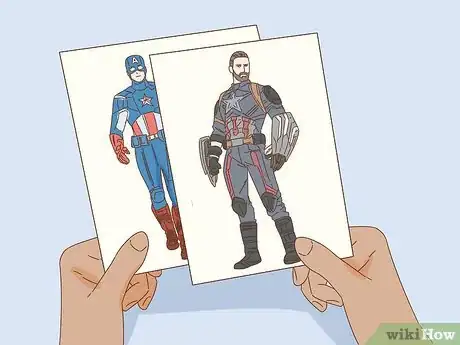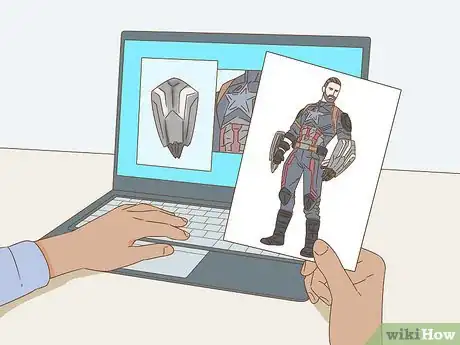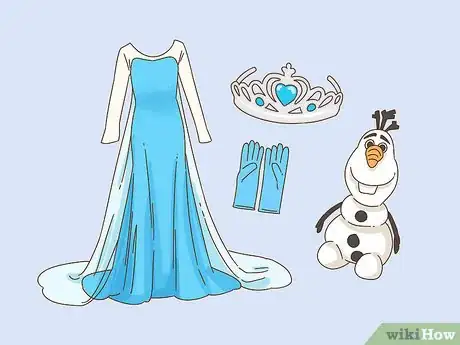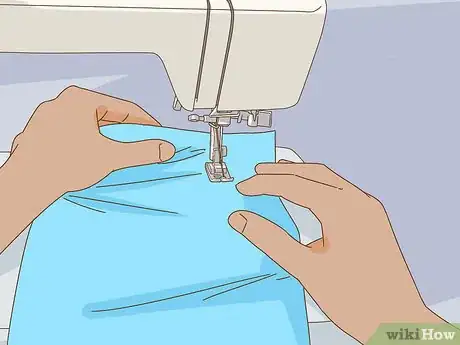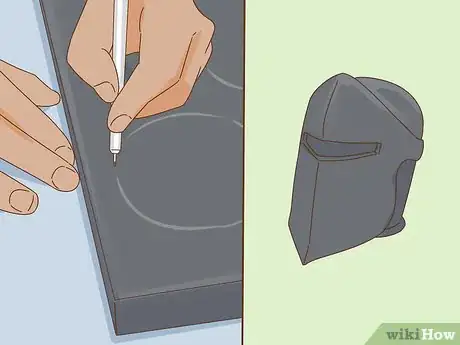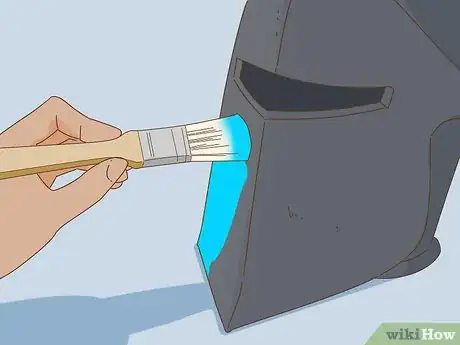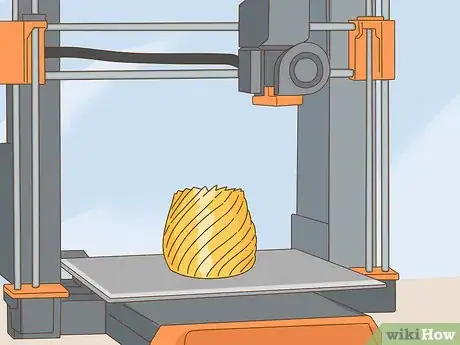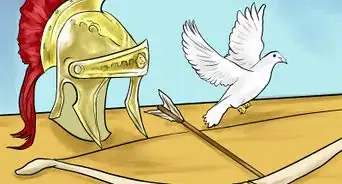This article was co-authored by wikiHow Staff. Our trained team of editors and researchers validate articles for accuracy and comprehensiveness. wikiHow's Content Management Team carefully monitors the work from our editorial staff to ensure that each article is backed by trusted research and meets our high quality standards.
There are 23 references cited in this article, which can be found at the bottom of the page.
wikiHow marks an article as reader-approved once it receives enough positive feedback. In this case, 88% of readers who voted found the article helpful, earning it our reader-approved status.
This article has been viewed 399,773 times.
Learn more...
Putting together a cosplay costume can be fun way to celebrate your favorite anime, video game, movie, or comic book series and show off your creativity in the process. First, choose the character you want to become. Then, study detailed images of your character and make a note of their clothing, hairstyle, accessories, and other important features. Familiarizing yourself with your character’s appearance will help you shop for components that look the part, or fashion your own one-of-a-kind items at home.
Steps
Choosing a Character
-
1Make a list of possible characters that you’re interested in cosplaying. Come up with a broad selection of characters, drawing inspiration from many different forms of media. For example, you might pick out 1 or 2 characters from various entertainment categories, then narrow down your choices to the one that you think is the most fitting or will be the most fun to realize.[1]
- In order to choose the perfect cosplay character, first think about what you like. What is your current obsession? What sorts of things do you most enjoy watching or playing? Questions like these can help you pinpoint a character that best represents your interests.
- The character you cosplay could be from a TV show, movie, video game, anime, comic book, musical group, or even real life.
Tip: Don’t feel like you can’t dress up as a certain character because they’re a different ethnicity, gender, or species. With cosplay, you’re free to be anything you want to be![2]
-
2Decide which version of the character to portray. Once you’ve made up your mind on a character to embody, give some thought to the specific costume design that you like the best. Many characters have more than one outfit or look that they’re known for. This means you have all sorts of options to choose from even after you’ve committed to a character.[3]
- If you’re planning on cosplaying Vegeta from Dragonball Z, you might stick with his regular Saiyan armor, or go with a less common variant like his sleeveless blue training outfit or casual pink shirt and yellow pants ensemble.[4]
- People will be more likely to recognize you as the main version of your character, but exploring alternate costume ideas can give you the chance to do something unique.
- You’re also free to invent your own totally original costume concepts by blending themes or elements from different titles and genres, such as Jedi Harry Potter.[5]
Advertisement -
3Study images of your chosen character closely. Analyze every part of your character’s appearance in depth, from their clothing and hairstyle to their secondary features like weapons, armor, accessories, and tattoos. You’ll need to have a detailed picture of these things in mind moving forward in order to construct a costume that’s complete and accurate.[6]
- Search the Internet for high-res screenshots that clearly highlight every part of the costume. If you can’t find any good full-body shots, try saving multiple photos that show the character from different angles.
- There are plenty of 3D models for video game characters available online. These can come in handy for crafting costumes, as they offer a full 360-degree view of the character.[7]
-
4Settle for a costume that you can actually pull off. While there’s theoretically no limit to what you can create, some costumes will be easier to bring to life than others. It’s easy enough to decide that you want to be Iron Man, but making it happen is a different story. Keep in mind that you’ll be responsible for buying or making all of the components of your costume.[8]
- Don’t forget to consider logistical factors, as well, such as when and where you’ll be sporting your costume. An enclosed bodysuit with a helmet, gloves, and heavy boots may just be too plain hot to wear to a convention in the middle of summer.
- Challenges can fuel your creativity, but if you can’t think of a good way to make your costume a reality, you may have no choice but to scrap your original idea and go back to the drawing board.
-
5Make sure your costume is appropriate for any events you might attend. Unless you're dressing up for a convention or exhibition intended for adults only, steer clear of gruesome, revealing, or overly-mature costumes. There are likely to be children and families present at most events where people tend to cosplay, and not everyone will be as taken with your presentation as you are.[9]
- Check the costume guidelines before you show up. Event organizers sometimes impose rules forbidding attendees from wearing anything that could be seen as crude or offensive.[10]
- If you’re not comfortable modeling your costume around your own family, it’s probably best not to wear it to a public event.
Piecing Together Suitable Components
-
1Look for clothing and accessories that you can easily replicate. Before you drop a bunch of money on replica merchandise, dig through your closet and pull out anything you might be able to incorporate into your costume. For example, you may find an old vest that could pass for body armor, or repurpose protective sports equipment to serve as gauntlets or other accents.[11]
- Make a list of everything you need to assemble your costume and check it off as you continue to accumulate items.[12]
- To cosplay Jesse from Pokemon’s Team Rocket, for instance, all you really need is a white skirt, a white turtleneck that you can cut up and draw on, and long black gloves and boots.
Tip: As you familiarize yourself with your character, pay attention to the parts of their getup that resemble items you already own, or could with a little tweaking.
-
2Go thrifting for items that you don’t already have. There’s a good chance that if you can’t find something in your own closet, you’ll be able to find it at a thrift store. Basic items like shoes, gloves, hats, and belts tend to be inexpensive, and can all be modified easily. The same goes for main articles of clothing like pants, shirts, and outerwear.[13]
- You may also be able to turn up smaller accessories like bags, glasses, jewelry, and wigs at a thrift store.
- Take your reference images to the store with you to make sure you’re picking out colors, patterns, and materials that are a match.[14]
-
3Use makeup to recreate your character’s other prominent features. In addition to clothing, accessories, and props, many cosplay projects require the use of makeup effects. A little blush, eye shadow, or toner may be all you need to apply the finishing touches to simpler costumes. Other times, it may take a steady hand with a paintbrush or even a full coat of body paint to make yourself look the part.[15]
- Refer back to the images you’ve collected of your character to make sure each of the fine details you brush on is neat and accurate.
- Invest in high quality sweat-proof makeup and paint products if you’re going to be spending long periods of time in your costume. Chances are, you’ll get pretty hot—if you’re not careful, all your hard work could end up running down your face by lunchtime.[16]
-
4Ask to borrow components from other cosplayers. If you know someone who’s made a similar costume in the past or has a certain piece that could work for your project, see if they’d be willing to lend it to you. The best part about borrowing props and accessories is that all the labor has already been done for you, which means you won’t have to spend a dime or carve out extra crafting time.[17]
- Be sure to get your friend’s permission before making any modifications to their creations.
- Take good care of the pieces you borrow. Your friend is doing you a favor by loaning them out to you, so it’s important not to dirty them up or damage them in any way.
-
5Consider buying a replica costume to save time and effort. Part of the fun of cosplay is sourcing your own costume components, but there’s no rule that says you have to. These days, you can find readymade costumes from all sorts of different popular franchises at any costume shop. Purchasing everything you need in one convenient package could be a good fallback plan if you’re more interested in wearing your costume than watching it come together.[18]
- Costume stores can also be a lifesaver when you’re just looking for one or two elusive items to complete a costume. A prop trident, for instance, could be all that’s missing from your homemade Aquaman costume.
- If you can’t find the exact costume you want in stores, try searching for it online.
Fashioning Items You Can’t Buy
-
1Learn how to sew to make fabric components from scratch. If you’re unable to find the exact clothing items you need for your costume, your best course of action is to teach yourself a little bit about sewing. Look up tutorials for basic sewing techniques and follow along. Once you’ve sharpened your skills, you’ll be able to turn ordinary fabrics into one-of-a-kind garments.[19]
- Having some sewing skills in your repertoire is also useful for adding embellishments to items to make them more faithful to your source material.
- Record all of your major measurements (shoulders, chest, waist, hips, thighs, and inseam) so you’ll be able to tailor your custom clothing to your frame.[20]
Tip: Working with sewing patterns can spare you lots of trial and error and ensure neat, polished results when stitching original costume elements.
-
2Make basic accessories out of cardboard or plywood. Both of these materials are incredibly useful for crafting armor, shields, weapons, and anything else that’s made up of flat surfaces and angles. Not only are they cheap and easy to come by, they can also be cut, shaped, painted, and glued or taped without any special know-how.[21]
- Rummage through your closets or garage to search for scrap cardboard or plywood that you might be able to convert to costume components. If you don’t have any luck, ask around at area businesses—many stores give away old boxes for free.[22]
- Plywood will hold up better than cardboard if you’re going to be moving around in your costume or packing it up to transport it.
-
3Experiment with EVA foam for crafting complex accessories. You can make almost anything out of EVA foam. Just sketch your design onto a sheet of the proper thickness and density and carefully cut out the pieces using a utility knife. Hot-glue the individual pieces together, carve out fine details with your utility knife, then paint your props to add color and texture.[23]
- You can buy sheets of EVA foam at any craft store for just a few dollars.
- Browse user-submitted templates for various weapons and accessories on cosplay websites and message boards, or simply have fun figuring out how to put things together yourself.[24]
-
4Modify the color and texture of your components with paints and dyes. If you find a piece that’s the perfect fit but the wrong color, dying it is a quick and easy fix. Similarly, fabric paints make it possible to add detailed design elements to plain garments. Between sewing and recoloring, you should never find yourself stumped about how to pull off tricky costume components again.[25]
- Natural fabrics like cotton and linen tend to accept and hold color better than synthetic ones.
- With only some fabric paint and a few DIY stencils, you could transform a cheap shirt and pair of pants into a screen-accurate “Star Trek” uniform.
-
53D-print especially difficult or complicated pieces. Sometimes, there will be too much going on with a particular accessory to successfully recreate it using household items or materials like EVA foam. In these cases, it can be helpful to make use of a 3D printer or 3D printing business in your area. The printer will take care of the hard part for you, which means all you have to worry about is applying the finishing touches.[26]
- Many companies will 3D print custom items for a price. The cost of these services may vary depending on the size, complexity, and material of your item.
- If you plan on making cosplay a long-term hobby, it will be worth your time to gain some experience with 3D design software like Meshmixer, FreeCAD, or Vectary that you can use to create your own models for printing.[27]
Community Q&A
-
QuestionCan I use makeup to cover my entire face for a good cosplay of Jasper from "Steven Universe"?
 Community AnswerYes, you can use makeup, but you should probably use face or body paint like Snazaroo, and not odd-colored eye shadow.
Community AnswerYes, you can use makeup, but you should probably use face or body paint like Snazaroo, and not odd-colored eye shadow. -
QuestionWhat is the most affordable way to make a cosplay if I don't want to sew?
 Community AnswerTry to find resources that can be part of your costume. Look in your wardrobe and find clothing that will match your cosplay. You can also go to stores and look for objects or pieces of clothing that will help your cosplay; thrift and second-hand stores are great for this!
Community AnswerTry to find resources that can be part of your costume. Look in your wardrobe and find clothing that will match your cosplay. You can also go to stores and look for objects or pieces of clothing that will help your cosplay; thrift and second-hand stores are great for this! -
QuestionWhat if it's my first time cosplaying, and I have my heart set on a costume?
 GarrettTop AnswererJust do it. Don't let your dreams be dreams.
GarrettTop AnswererJust do it. Don't let your dreams be dreams.
Warnings
- Make sure your costume is appropriate for any events you’ll be attending. If you're going to an public exhibition where there will be children or families present, a skimpy fanservice costume not be the best choice.⧼thumbs_response⧽
- You may not be permitted to enter certain events with realistic prop weapons. In some cases, these items could be confiscated by security.⧼thumbs_response⧽
References
- ↑ https://observationdeck.kinja.com/cosplay-1-01-a-beginners-introduction-to-cosplay-1632337814
- ↑ https://www.tor.com/2016/10/07/cosplay-a-place-for-expression-and-inclusivity-at-nycc/
- ↑ https://www.mookychick.co.uk/how-to/interesting-hobbies/cosplay-costumes-dos-donts.php
- ↑ https://www.cbr.com/dragon-ball-z-vegetas-best-looks-ranked/
- ↑ https://thedailyfandom.com/cosplay-101-8-tips-tricks/
- ↑ https://makezine.com/2017/10/20/cosplayers-share-tips-tools-ingenuity-inspire-get-started/
- ↑ https://www.kamuicosplay.com/2012/10/16/make-your-first-cosplay-steps/
- ↑ https://www.kamuicosplay.com/2012/10/16/make-your-first-cosplay-steps/
- ↑ http://www.goldenlasso.net/what-is-inappropriate-cosplay/
- ↑ https://www.cityoforange.org/1818/Comic-Con-2018-Cosplay-Rules
- ↑ https://www.techtimes.com/articles/84599/20150915/cosplay-101-how-to-create-a-costume-on-a-budget.htm
- ↑ https://observationdeck.kinja.com/cosplay-1-01-a-beginners-introduction-to-cosplay-1632337814
- ↑ http://www.mugglenet.com/2017/08/thrift-shop-cosplay/
- ↑ https://www.youtube.com/watch?v=taDXM_2v2Uw&feature=youtu.be&t=90
- ↑ https://thedailyfandom.com/cosplay-101-8-tips-tricks/
- ↑ https://aminoapps.com/c/cosplay/page/blog/body-paint-breakdown/0gUk_uQpvm0zR6pWVGrzve124zqX2a
- ↑ https://medium.com/@slyder_ryley/tips-on-how-to-cosplay-on-a-budget-a05ba6199cc8
- ↑ https://aminoapps.com/c/cosplay/page/blog/made-vs-bought-cosplay-cosplayamino2017/doUb_umW70DPD65Wp3lmGv1vndmEao
- ↑ http://thosecosplaygals.tumblr.com/post/61989879811/ambers-beginners-guide-to-sewing-cosplay
- ↑ https://www.clothingpatterns101.com/body-measurements.html
- ↑ https://www.nytimes.com/2018/10/29/style/best-cosplay-costumes.html
- ↑ https://www.unpakt.com/blog/top-7-places-to-find-free-moving-boxes/
- ↑ https://makezine.com/2016/09/06/working-with-pva-foam-for-costume-construction/
- ↑ https://www.therpf.com/forums/threads/jfcustoms-foam-files.148889/
- ↑ https://www.techtimes.com/articles/84599/20150915/cosplay-101-how-to-create-a-costume-on-a-budget.htm
- ↑ https://all3dp.com/2/3d-printer-for-cosplay-what-to-consider-which-to-choose/
- ↑ https://all3dp.com/1/best-free-3d-printing-software-3d-printer-program/
About This Article
Making a cosplay costume is a fun way to celebrate your favorite character and show off your creative side. Once you pick your character, study images of them to get all of the details down. Go through your closet to see if you have anything that you can use for your costume. Then, go to a thrift store to purchase any other items that you’ll need to complete your costume. You can also ask other cosplayers if you can borrow parts of their old costumes if there are certain pieces that would work for your project. Plan to make basic accessories, like armor, shields, and weapons, out of cardboard or plywood. You can also experiment with EVA foam to craft complex accessories. To learn how to use paints and dyes to make found pieces a perfect fit for your costume, keep reading!

